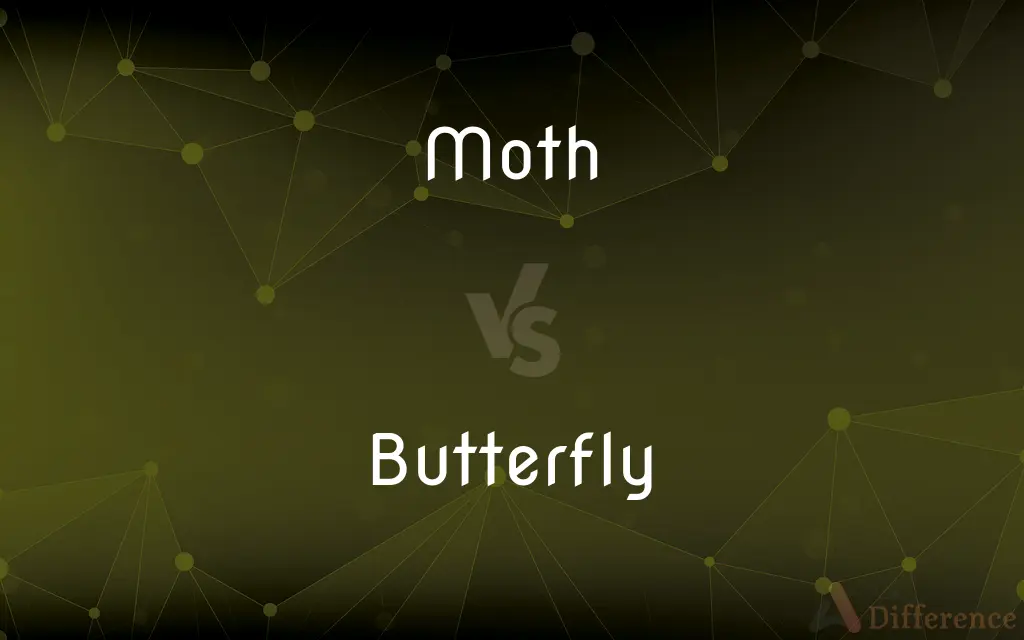Moth vs. Butterfly — What's the Difference?
By Fiza Rafique & Urooj Arif — Updated on March 25, 2024
Moths are generally nocturnal with feathery antennae, while butterflies are diurnal with club-shaped antennae.

Difference Between Moth and Butterfly
Table of Contents
ADVERTISEMENT
Key Differences
Moths and butterflies belong to the order Lepidoptera, but moths usually have feathery or filamentous antennae and are primarily active at night. Butterflies, in contrast, are known for their club-shaped antennae and are active during the day.
The wing structure and resting posture differ as well; moths tend to rest with their wings spread out flat or tented over their bodies. Butterflies usually rest with their wings held upright over their backs.
Moths typically have a more subdued or camouflaged coloration, which helps them blend into their surroundings at night. Butterflies tend to have more vibrant colors and patterns on their wings, which serve as a mechanism for temperature regulation and predator deterrence during the day.
The ecological roles and behaviors of moths and butterflies vary. Moths are crucial pollinators at night and have a broader range of habitats, including some extreme environments. Butterflies are important for daytime pollination and are often used as indicators of environmental health due to their sensitivity to habitat changes.
Comparison Chart
Activity Time
Primarily nocturnal
Diurnal
ADVERTISEMENT
Antennae Shape
Feathery or filamentous
Club-shaped
Metamorphosis
Cocoon
Chrysalis
Wing Resting Posture
Spread out flat or tented over their body
Held upright over their back
Coloration
Subdued, camouflaged
Vibrant, colorful
Ecological Role
Pollinators at night, wider range of habitats
Daytime pollinators, indicators of environmental health
Compare with Definitions
Moth
Mostly active at night and attracted to lights.
At night, you can see moths gathered around porch lights.
Butterfly
A diurnal insect of the order Lepidoptera known for its vibrant wings and club-shaped antennae.
Monarch butterflies are famous for their long migration journeys.
Moth
Generally more subdued or camouflaged.
Many moths have wing patterns that mimic the bark of trees.
Butterfly
Active during the day, especially in sunny, warm conditions.
Butterflies can be seen fluttering in gardens during daylight.
Moth
Typically feathery or filamentous, aiding in sensory functions.
Moths use their feathery antennae to detect pheromones released by potential mates.
Butterfly
Serve as pollinators and indicators of environmental health.
Butterfly populations are monitored as a gauge for ecosystem health.
Moth
Important nocturnal pollinators and food for many predators.
Moths play a crucial role in pollinating nocturnal flowers.
Butterfly
Club-shaped, which is a distinctive feature.
Butterflies use their club-shaped antennae for balance and sensing.
Moth
A nocturnal insect of the order Lepidoptera with feathery or filamentous antennae.
The silk moth is known for its role in silk production.
Butterfly
Often vibrant and colorful, with patterns serving various ecological roles.
The bright colors of butterflies can warn predators of their toxicity.
Moth
Moths are a paraphyletic group of insects that includes all members of the order Lepidoptera that are not butterflies, with moths making up the vast majority of the order. There are thought to be approximately 160,000 species of moth, many of which have yet to be described.
Butterfly
Talk or behave amorously, without serious intentions;
The guys always try to chat up the new secretaries
My husband never flirts with other women
Moth
Any of numerous insects of the order Lepidoptera, generally distinguished from butterflies by their nocturnal activity, hairlike or feathery antennae, stout bodies, and the frenulum that holds the front and back wings together.
Butterfly
A nectar-feeding insect with two pairs of large, typically brightly coloured wings that are covered with microscopic scales. Butterflies are distinguished from moths by having clubbed or dilated antennae, holding their wings erect when at rest, and being active by day.
Moth
A clothes moth.
Butterfly
A stroke in swimming in which both arms are raised out of the water and lifted forwards together.
Moth
A usually nocturnal insect of the order Lepidoptera, distinguished from butterflies by feather-like antennae.
Butterfly
Split (a piece of meat or fish) almost in two and spread it out flat
Butterfly the shrimp using a small sharp knife
Moth
(figurative) Anything that gradually and silently eats, consumes, or wastes any other thing.
Butterfly
Any of numerous insects of the order Lepidoptera, having four broad, usually colorful wings, and generally distinguished from the moths by having a slender body and knobbed antennae and being active during the day.
Moth
The plant Vigna aconitifolia, moth bean.
Butterfly
A person interested principally in frivolous pleasure
A social butterfly.
Moth
(intransitive) To hunt for moths.
Butterfly
A swimming stroke in which a swimmer lying face down draws both arms upward out of the water, thrusts them forward, and draws them back under the water in an hourglass design while performing a dolphin kick.
Moth
A mote.
Butterfly
A race or a leg of a race in which this stroke is swum.
Moth
Any nocturnal lepidopterous insect, or any not included among the butterflies; as, the luna moth; Io moth; hawk moth.
Butterfly
Butterflies A feeling of unease or mild nausea caused especially by fearful anticipation.
Moth
Any lepidopterous insect that feeds upon garments, grain, etc.; as, the clothes moth; grain moth; bee moth. See these terms under Clothes, Grain, etc.
Butterfly
To cut and spread open and flat, as shrimp.
Moth
Any one of various other insects that destroy woolen and fur goods, etc., esp. the larvæ of several species of beetles of the genera Dermestes and Anthrenus. Carpet moths are often the larvæ of Anthrenus. See Carpet beetle, under Carpet, Dermestes, Anthrenus.
Butterfly
A flying insect of the order Lepidoptera, distinguished from moths by their diurnal activity and generally brighter colouring.
Moth
Anything which gradually and silently eats, consumes, or wastes any other thing.
Butterfly
A use of surgical tape, cut into thin strips and placed across an open wound to hold it closed.
Butterfly tape; butterfly bandage; butterfly strips
Moth
Typically crepuscular or nocturnal insect having a stout body and feathery or hairlike antennae
Butterfly
(swimming) The butterfly stroke.
Butterfly
Any of several plane curves that look like a butterfly; see Butterfly curve (transcendental) and Butterfly curve (algebraic). Category:en:Curves
Butterfly
(in plural) A sensation of excited anxiety felt in the stomach.
I get terrible butterflies before an exam.
Butterfly
Someone seen as being unserious and (originally) dressed gaudily; someone flighty and unreliable.
Butterfly
(finance) A combination of four options of the same type at three strike prices giving limited profit and limited risk.
Butterfly
(alternate history) A random change in an aspect of the timeline seemingly unrelated to the primary point of divergence, resulting from the butterfly effect.
One potential butterfly could be JFK having another son the year after the POD instead of a daughter.
Butterfly
(sports) A type of stretch in which one sits on the ground with the legs folded into a shape like that of a butterfly's wings, slightly rocking them up and down, resembling the wings fluttering.
Butterfly
A person who changes partners frequently.
Butterfly
(transitive) To cut (food) almost entirely in half and spread the halves apart, in a shape suggesting the wings of a butterfly.
Butterflied shrimp
Butterfly the chicken before you grill it.
Butterfly
(transitive) To cut strips of surgical tape or plasters into thin strips, and place across (a gaping wound) to close it.
Butterfly
To cause events after the point of divergence to not happen as they did in real history, and people conceived after the point of divergence to not exist in recognizable form, due to the random variations introduced by the butterfly effect.
Pearl Harbor not happening would've butterflied Taylor Swift.
Butterfly
A general name for the numerous species of diurnal Lepidoptera.
Butterfly
Diurnal insect typically having a slender body with knobbed antennae and broad colorful wings
Butterfly
A swimming stroke in which the arms are thrown forward together out of the water while the feet kick up and down
Butterfly
Flutter like a butterfly
Butterfly
Cut and spread open, as in preparation for cooking;
Butterflied shrimp
Common Curiosities
Do all butterflies migrate like monarchs?
Not all; migration patterns vary widely among butterfly species.
Are moths and butterflies related?
Yes, they both belong to the order Lepidoptera.
Can moths be colorful like butterflies?
While generally more subdued, some moths are indeed colorful.
What distinguishes a moth from a butterfly?
Key differences include activity time, antennae shape, and wing resting posture.
Why are moths attracted to light?
It's believed to be related to their navigation by natural light sources like the moon.
How do moths pollinate at night?
They visit nocturnal flowers, using their long proboscis to reach nectar.
How can I attract butterflies to my garden?
Plant native flowering plants and provide sunny, sheltered areas.
Why do butterflies have vibrant colors?
For various reasons, including temperature regulation, mating, and predator deterrence.
Are butterflies active in cold weather?
They are less active in cold weather, preferring warm, sunny conditions.
What is a butterfly's lifespan?
Lifespan varies by species, ranging from a few weeks to several months.
Can moths eat clothes?
Only certain species of moths, like the clothes moth, eat fabric.
Why are butterflies important for the environment?
They pollinate plants and serve as indicators of environmental health.
Do moths and butterflies have a sense of smell?
Yes, they have a well-developed sense of smell, crucial for finding mates and food.
What role do caterpillars play in the ecosystem?
As larvae of moths and butterflies, they are a vital food source for various animals.
Share Your Discovery

Previous Comparison
Courage vs. Guts
Next Comparison
Handwriting vs. PenmanshipAuthor Spotlight
Written by
Fiza RafiqueFiza Rafique is a skilled content writer at AskDifference.com, where she meticulously refines and enhances written pieces. Drawing from her vast editorial expertise, Fiza ensures clarity, accuracy, and precision in every article. Passionate about language, she continually seeks to elevate the quality of content for readers worldwide.
Co-written by
Urooj ArifUrooj is a skilled content writer at Ask Difference, known for her exceptional ability to simplify complex topics into engaging and informative content. With a passion for research and a flair for clear, concise writing, she consistently delivers articles that resonate with our diverse audience.















































